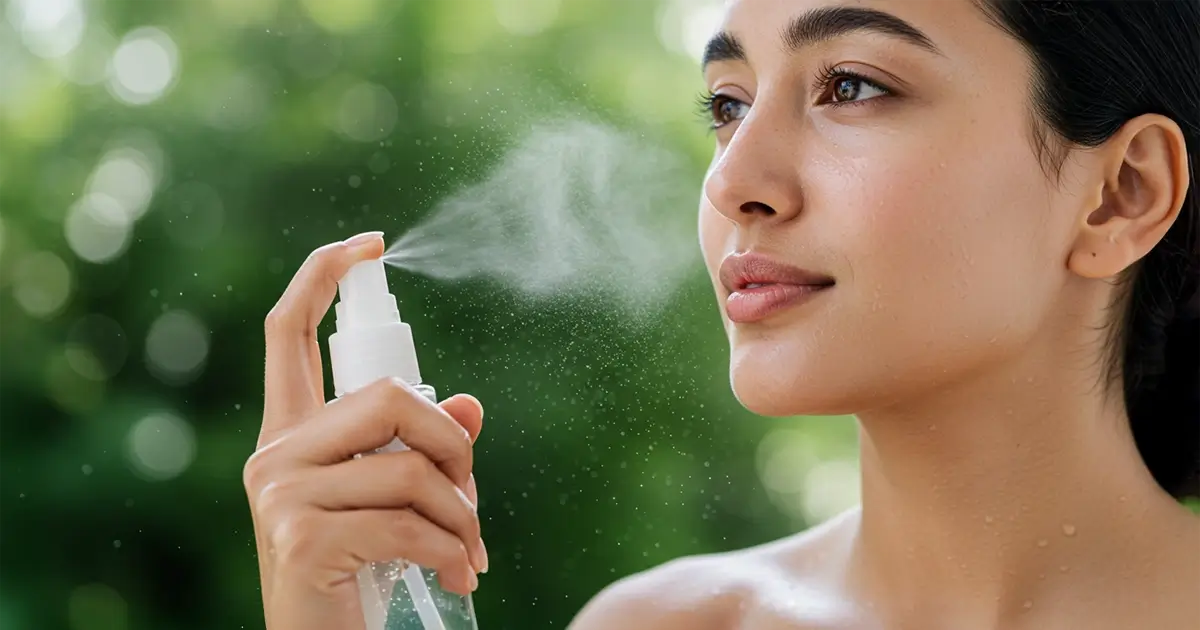I adore a quick, cooling face spray, but when I realised prebiotic mists could also train my skin's living layer to behave, I felt like I'd unlocked a secret menu. Stick with me to learn the science behind those airy droplets, practical ways to pick or mix a bottle, and clever tricks that make the habit feel as natural as breathing.
Why the Skin's Living Layer Deserves Attention
The microbiome is a microscopic neighbourhood wrapped around us, buzzing with friendly Staphylococcus epidermidis, opportunistic Cutibacterium acnes, and a smattering of fungi that mostly keep to themselves. When the good neighbours win the popularity contest, our barrier stays intact, pH holds steady, and inflammatory molecules stay snoozing. If a string of late nights, harsh cleansers, or urban smog tips the balance, troublemakers latch on and redness moves in like an uninvited band.
Prebiotic mists sway that balance by sliding plant sugars onto the skin, which the helpful strains ferment into short-chain fatty acids. These metabolites gently lower pH and produce antimicrobial peptides, nudging unfriendly species to pack their bags. The process is quiet - no overnight fireworks - but over weeks the barrier thickens, ceramides climb, and the surface feels less "squeaky" after cleansing.
The idea carries hard data. A 2024 JAMA Dermatology study followed adults using an inulin-rich spray twice daily for eight weeks and logged a 25 percent drop in transepidermal water loss alongside higher cholesterol-type lipids. Translation: moisture stayed put even when heaters blasted through winter.
Beyond barrier perks, balanced flora seems to dampen inflammatory cascades linked to hormonal breakouts. Participants tracked fewer angry papules during luteal phases, hinting that a resilient biome can buffer hormonal swings. Is it a magic shield? No - but it is a persuasive bouncer at the club door.
Prebiotic Ingredients: From Soil to Spray Bottle
Ingredient lists look dense, yet three major sugars lead the charge: inulin, alpha-glucan oligosaccharide, and fructo-oligosaccharide. Each feeds slightly different bacterial families, so blends often cover more microbial bases. Brands pair them with fermented filtrates - think lactobacillus ferment extract - adding peptides that coax keratinocytes to pump out antioxidants.
If you spot "galacto-oligosaccharide," that sugar was first popular in infant formula before dermatologists borrowed it for eczema-prone adults. Clever crossover, right? Variety matters, but be wary of formulas that trumpet "prebiotic" then hide the sugar beyond the eleventh spot. Anything buried that deep wears too small a hat to run the show.
Key Prebiotic Sugars to Recognise
- Inulin: Extracted from chicory root or agave, water-soluble, and heat-stable up to 80 °C.
- Alpha-glucan oligosaccharide: Short chains that nestle between corneocytes and cushion the acid mantle.
- Fructo-oligosaccharide: Fermented by Streptococcus thermophilus, resulting acids calm redness remarkably fast in patch tests.
Fermentation Versus Isolation
Isolated sugars are predictable, but fermented filtrates add bioactive goodies that signal skin cells to make more glutathione. Sensitive faces should start with isolated sugars because predictable beats dramatic, yet most people can jump straight into the ferment party.
Choosing or DIY-ing a Daily Mist
Skincare aisles range from bargain bins to bottles priced like weekend flights. Ignore glittering adjectives and scan the first five ingredients: if you see inulin, lactobacillus ferment filtrate, or another prebiotic early, you are on the right track. Humectants such as glycerin or propanediol should follow close behind to keep water anchored.
Keen on kitchen science? Dissolve one gram of powdered inulin and half a gram of panthenol in 100 ml of boiled, cooled water. Add two drops of phenoxyethanol plus ethylhexylglycerin, then funnel the mix into a sterile cobalt glass bottle. Chill below 8 °C and use within seven days. It smells like absolutely nothing - welcome news for scent-sensitive noses.
Store-bought or homemade, patch-test both. Spray a coin-sized patch on your inner arm twice daily for three days. No redness, itching, or bumpy drama? Your face gets the green light.
Storage Hacks
Prebiotics wilt under heat faster than iceberg lettuce in sunshine. Keep the bottle below 25 °C or pop it into the refrigerator door. A chilled spritz at 3 pm stops my brain from typing "adfgbz" in Slack when the afternoon slump kicks in.
Integrating the Mist into a Busy Routine
Morning juggling act? Simplify: gentle cleanse, pat dry, spritz, wait ten seconds, then layer antioxidant serum and sunscreen. The pause lets sugars land evenly so the next product does not glide off in streaks.
Lunchtime in air-conditioned offices turns cheeks papery. Two mid-face sprays from 20 cm away revive makeup without breaking coverage. I press droplets with my pinky knuckle - palms remove foundation more than they pat it in.
Nighttime double cleansing can strip lipids, so mist before exfoliants. Alpha-hydroxy acids spread more smoothly on hydrated skin, and those sugars buffer the sting. Follow with a ceramide-rich cream to seal the tiny water reservoir you just built.
A Practical All-Day Schedule
- 07:30 – Cleanse, prebiotic mist, vitamin C, sunscreen.
- 13:00 – Desk spritz, blot gently, reapply SPF if you venture outside.
- 19:30 – Double cleanse, mist, gentle chemical exfoliant twice a week, moisturizer.
Synergy with Potent Actives
- Retinoids: mist first, wait, apply retinoid, wait, moisturize. The waits matter - think LEGO bricks that need a click-in moment.
- Azelaic acid: sugars soften the initial tingle when layered beforehand.
- Benzoyl peroxide: keep them apart by at least fifteen minutes; oxidative stress unsettles helpful microbes.
- Niacinamide: pairs like peanut butter and jelly, boosting both barrier repair and redness reduction.
Tracking Progress Without a Microscope
Expect subtle gains before bold headlines. Weeks one and two usually bring smoother texture rather than Instagram-worthy glow. By week three, watch nostril edges and jawline hot spots; fewer flare-ups there mark genuine biome harmony.
Consider weekly photos under identical light. The side-by-side comparison shows tone evening you might miss daily. Hydration meters, if you geek out on gadgets, often jump eight to twelve percent within a month, but "I woke up less tight" is valid evidence too.
- Monitor how quickly a tweezer nick closes.
- Notice midday shine mellowing from slick to satin.
- Count inflammatory papules weekly; aim for a slow decline.
- Observe whether makeup creases less by late afternoon.
Everyday Anecdotes: Successes and Surprises
Five friends tested a chicory-inulin mist for four weeks. Four reported "improved comfort" and fewer random itches. One developed tiny whiteheads on her chin; we learned she sprayed over unrinsed oil-cleanser residue - proving sugars can cling to grime if you skip a rinse.
My partner, not usually poetic, called the chilled mist "like an alpine breeze sneaking through city traffic," then promptly stole my bottle. He now keeps one in the fridge door next to pickles - a small domestic victory I did not anticipate.
Environmental Factors That Influence Your Biome
Climate, pollution, and even household water hardness tug at microbial balance. Hot, humid air favours sweat-loving bacteria that can overproduce lipases and trigger acne. Dry alpine climates, on the other hand, whittle lipid layers until opportunistic fungi sneak in, sparking flakiness.
Polluted cities deliver particulate matter that nests inside pores within hours. Those particles carry heavy metals which reactive oxygen species feast on, damaging cell membranes and leaving your microbiome scrambling to detox. A prebiotic mist cannot block particles, yet feeding helpful strains amps up their antioxidant enzyme output, keeping free-radical mess lower.
If you are curious about broader strategies that nurture good microbes beyond mists, my deeper dive on holistic habits lives here: microbiome-friendly care guide.
Common Mist Mistakes and How to Dodge Them
Mist habit looks foolproof, yet three frequent missteps sabotage progress.
- Spraying too close: Droplets pool and run, taking makeup with them. Hold at least 15 cm away.
- Skipping preservatives in DIY versions: Sugar water breeds microbes at frightening speed; add a broad-spectrum preservative or ditch after seven days.
- Using as a makeup setting spray: Most prebiotic mists lack film-formers. Instead, mist first, let it settle, then set with an actual setting product.
FAQ
Does a prebiotic mist replace moisturizer?
No. The mist supplies water and microbial snacks, while moisturizer locks those goodies in with lipids.
Can I layer a probiotic serum right after?
Yes. Think of the mist as the appetiser and the serum as the main course for friendly flora.
Is mineral water enough for a DIY version?
Better to boil and cool tap water, then add preservative. Mineral water alone can still introduce spores.
Will the mist fade acne scars?
It curbs new inflammation, reducing future scarring, but old scars need targeted actives like retinoids or peptides.
How often should I spray on a flight?
Every two hours. Cabin humidity often drops under 20 percent, so light layers beat a single drenching.
Conclusion
Prebiotic daily mists quietly fortify the skin's ecosystem, strengthen the barrier, and make potent actives behave. Results arrive in calm waves rather than flashy displays, yet the reward - resilient, self-sufficient skin - makes those extra spritzes feel like second nature.
Stories, victories, or face-palm fails? Share below. See you in the next post - until then, take good care of your skin!


Comments (0)
No comments yet - be the first to share your thoughts!
Leave a Reply
Your email address will not be published. Required fields are marked *